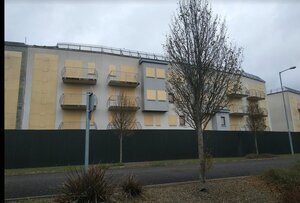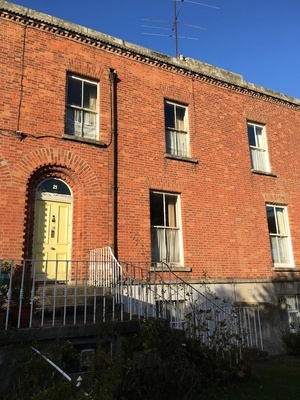Eglinton Road, Bray, County Wicklow
Anon writes:
In Eglinton Road, in Bray there’s four vacant houses, all two-storey gaffs with converted basements. They have been vacant for years. They back on to a Wicklow County Council site that’s set to become a shopping centre…
Anyone?
Empty gaffs to broadsheet@broadsheet.ie marked ‘Empty Gaffs’
Sponsored Link








property owner leaves house empty, oh the shame!
Should be subject to a Compulsory purchase order by the state and we’ll soon see the shameful waster up in court begging for it back, no?
A CPO would have to pay the owner the value of the property.
If these properties are vacant because they are part of larger parcel of land that is going to be a shopping centre then their value as ‘3-bed terraced homes’ may be, say, 400K; but the value of the land as shopping centre frontage may be 800K.
If Bray council have, say, €1.6m for housing they can either buy 2 of these (@800K each) or look elsewhere for 4 houses @400K… which makes more sense?
[aside: Bray should charge the owner 5K/year as a vacant property tax to incentivise the owners to get off the pot]
The council might own them if they came with the car park bought from Ballymore
Bray Town Council has purchased the site of the proposed Florentine Shopping Centre in Bray which has been vacant for the last 10 years for just €1.95 million. The council bought the site from Grant Thornton, the receiver of Florentine Properties Ltd, a company formerly controlled by Sean Mulryan’s Ballymore Properties. Accounts for this company show it had bank debts of €23 million.
Please subscribe or sign in to continue reading.
Bray Town Council has not existed since 2014. Nor has any town council. They were all abolished and incorporated into county councils.
What do you propose we do? Start seizing peoples properties?
Even if these were to be acquired by the state, how long and how much would renovations cost?
Who would get the houses?
Who do you think?
Illegal immigrants?
Blind people with guide dogs?
Maybe something like this? https://www.irishtimes.com/life-and-style/homes-and-property/smart-initiative-by-peter-mcverry-trust-breathes-new-life-into-vacant-city-homes-1.3070006
I’d propose nothing too communist like you mentioned, but definitely room (pardon the pun) for a vacant property tax no? Of course owners should have the right to leave properties vacant or to buy for the sake of investing/speculation, but surely they should be penalised for taking up a scarce resource (housing/land zoned for housing) especially when there’s such a demand and shortage for housing?
looking after those who cannot help themselves is now “communist”
I don’t think anyone’s property needs to be seized to ‘look after’ ‘those who can’t help themselves’
In my view we should just build more houses while utilising higher density developments in urban areas and those near major infrastructure links e.g. railways.
Any thoughts?
I’d agree.
if you were a developer with a prime site would you
a) start building now, under current medium-density rules, and make a medium return in 2 years
b) wait to see if the housing crises will change the rules to allow higher density, then build high-density, and make high return in 3 years?
[assuming that you have the leeway to do nothing for a few years]
In reply to you Cian, I’d most likely wait and see if I could get a bigger return if I was in that situation. I mean there’s no real incentive not to, unless you used a loan from the bank to purchase the site and will have them breathing down your neck for repayments. It appears a lot of the land sold by NAMA went to privately funded vulture funds who don’t have anyone awaiting repayment and are simply trying to maximise profits.
The ‘leeway to do nothing for a few years’ remark in your comment takes out the bank situation I outlined above, therefore I definitely would hang back and wait it out. Ideally this is where the vacant property tax would come in!
Also it’s a pity that the timelines you outline are probably roughly accurate. Shouldn’t take 2 years to go from a site to finished development, or an extra year for the outcome on planning restrictions and density changes to be unveiled. Alas, it probably will take as long.
Aaaaa – how long do you think it should / would take between the planning process (the appeals, the re-submission, the re-appeals, etc), getting the go-ahead, getting the electricity, water, waste, other services connected, Then there is connection of the roads, footpaths, streetlights, to say nothing of actually building the 200 houses. These things all take time.
How long ago was the RTE site sold? 9 acres for 500 apartments; 5 months in have they even started the planning process?
Cian,
Firstly I don’t think it should take a year to change the guidelines on housing height restrictions etc., but fear it will.
As regards the actual development, depends on what you’re building obviously. 1 month for high level design for submission to planning, 12 weeks is standard for planning. The physical building isn’t actually too onerous with 10 months being plenty of time for any regular medium sized development i.e. not high rise. The services and infrastructure can more or less be installed as you go. So I’d say a few months over a year for a medium sized development would be reasonable enough. What do you think?
As regards the RTE site, many motives could be behind the lack of development, not least waiting it out to see if they could get more units/acre depending on any imminent changes to planning guidelines.
“What do you propose we do? Start seizing peoples properties?”
No. Tax them.
Eminent domain Col, eminent domain.
I had to google that. You’re so knowledgeable.
+1 Col
If we had a more equitable (i.e. higher) property tax regime, we wouldn’t see so many empty properties.
Ha, your picture looks like a little langer.
yours looks like a fanny
Zing!
there’s a massive chunk of properties in nama and in receivership being bought by european pension funds. they’re signing long-term leases with local authorities for 25 years or more. it begs the question why we aren’t doing it ourselves?
Why would we be doing it?
The State borrowed billions to buy the properties for NAMA. NAMA needs to sell the properties to pay back the debt.
If NAMA keep the properties and lease them – the State still has that portion of the national debt.
The questions that should be asked are:
1. should the State borrow money (as national debt) to invest in companies/shares/properties/banks?
2. if yes to #1, should the State make the decision on which companies/shares/properties/banks to invest in based on some sort of research and make an actual decision OR based on the fact that we happen to currently have these properties/banks?
3. if the State does invests in companies/shares/properties/banks, will that cause conflict of interest down the line – if/when they need to create legislation [e.g. setting limits on the interest that Irish banks can charge. e.g. setting rent increase limits]
Interesting points. Excuse me if I’m misunderstanding, but in my view the difference between the govt investing in property as opposed to companies/shares, is that under normal conditions and throughout history, the govt ‘invests’ in property by building and maintaining social housing. The unprecedented nature of the bank guarantee and the setting up of NAMA means it’s hard to find a precedent, but wouldn’t it make sense to utilise the publicly owned land and developments (in NAMA), rather than selling them privately for little and going down the route of how they usually supply social housing?
it depends. Example:
a) NAMA have a one-acre site they can sell for €50 million.
b) The State need one-acre of land for 200 social houses.
Options:
1. the State uses the NAMA land and builds 200 social houses. Cost: €50m
2. NAMA sells the land for €50m; the State buys a different one-acre plot for €40 for 200 houses. Cost €40.
3. NAMA sells the land for €50m; the State buys a different one-acre plot for €60 for 200 houses. Cost €60.
Option 2 is the best option, followed by 1, then by 3.
I see your point and I think we’re on the same page. In short I’d suggest:
1. NAMA list the zoned land by value
2. Compare the value of the least valuable plots vs potential sites for outside of NAMA considered for social housing
3. Depending on the outcome, either transfer land from NAMA and build social housing or sell the NAMA sites, buy cheaper sites and build social housing.
On a side note – I think the problem with NAMA is they very rarely seem to sell single sites, but rather group them together in portfolios which are then sold, or keep the portfolios as they were grouped from when they took over the debt. Surely economies of scale would mean if they split the land up they could get better value for it I would have thought.
Aaaaa, “Surely economies of scale would mean if they split the land up they could get better value for it I would have thought.” again, it depends. They may get a better price for each plot, but they end up with higher costs to sell it. I don’t know if one would offset the other.
what is the value of a can of coke? If you buy it in a corner shop it’s €1.30; in your supermarket it’s €1 (or €.75 each of you are willing to buy 11 others); or €0.50 each in a wholesalers – if you buy 48.
Cian,
Offshoot of splitting the plots up is that the buyers are less likely to be huge investors/vulture funds and therefore I think there’d be a higher likelihood of actual developments starting on the land sold, with less being left lying around. Maybe that’s naive of me to think!
Aaa, I don’t actually know what it going on. The vulture funds are there to make money. I would have expected them to take the bundle, split it into the smaller sites and sell them off individually and turn over a quick profit.
I’d be surprised if they vulture funds are just sitting on land banks – it wouldn’t make sense. They are more likely to buy existing properties that are producing rent and squeezing more money out of them.
nice gaffs too
They’re part of the shopping centre. Will become offices
Sure for all we know they could well be in probate. There’s properties all over Dublin that are in limbo because of messy probate.
1-11 Eglington Road, Bray are all protected structures.
These are not cheap houses, they’re 250sqm period houses (ref 9 eglington road sold for €630k in 2015). Renovating them would cost s fortune as they need to be overseen by conservation architects & an Taisc/The Georgian Society would be all over this like a rash.
+1
Is your comment getting at their unsuitability for social housing or housing in general? I have a feeling there would be plenty of people willing to pay to have them refurbished if they could purchase them in the first place.
Hardly brayking news.